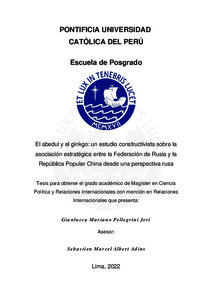| dc.contributor.advisor | Adins Vanbiervliet, Sebastien Marcel Albert | |
| dc.contributor.author | Pellegrini Jeri, Gianlucca Mariano | |
| dc.date.accessioned | 2022-09-27T06:21:31Z | |
| dc.date.available | 2022-09-27T06:21:31Z | |
| dc.date.created | 2022 | |
| dc.date.issued | 2022-09-27 | |
| dc.identifier.uri | http://hdl.handle.net/20.500.12404/23437 | |
| dc.description.abstract | En los últimos treinta años (1991-2021), la relación bilateral entre la Federación de Rusia y la
República Popular China ha evolucionado hasta convertirse en una asociación estratégica de
considerable relevancia en el desarrollo de las relaciones internacionales. Identificar las bases
sobre las que este vínculo se sostiene es esencial para explicar la creciente sintonía exhibida por
ambas naciones en materia de política exterior. La presente investigación se apoya en el marco
teórico de la escuela constructivista para analizar tres dimensiones de corte ideacional que
explican la convergencia entre Moscú y Pekín: el establecimiento de un orden internacional
multipolar o policéntrico, el respeto a los principios del derecho internacional y la identificación
de un “Otro” y la construcción de la identidad estatal. Para realizar este tipo de investigación, se
apela al análisis cualitativo de contenido tanto de los discursos y documentos oficiales emitidos
por las autoridades políticas de ambos países como de los documentos oficiales divulgados por
los BRICS y la Organización de Cooperación de Shanghái (OCS), dos espacios multilaterales
liderados por ambos países. Este estudio concluye que existe una significativa coincidencia entre
Rusia y China en la defensa de un orden internacional multipolar y el derecho internacional, pues
son causas funcionales a sus intereses nacionales; en cambio, más incierta y ambigua es la
confluencia respecto de la caracterización que cada uno hace de un “Otro” en el escenario
internacional, el grado de importancia que cada uno le asigna al momento de ejecutar su política
exterior y la forja de su identidad en el tablero internacional. | es_ES |
| dc.description.abstract | Over the last thirty years (1991-2021), the bilateral relationship between the Russian Federation
and the People's Republic of China has evolved into a strategic partnership of considerable
relevance in the development of international relations. Identifying the foundations on which
this bond is sustained is essential to explain the growing attunement exhibited by both nations
in foreign policy matters. This research is based on the theoretical framework of the
constructivist school in order to analyze three ideational dimensions that explain the
convergence between Moscow and Beijing: the establishment of a multipolar or polycentric
international order, respect for the principles of international law, and the identification of an
"Other" and the construction of state identity. In order to carry out this type of research,
qualitative content analysis of both the speeches and official documents issued by the political
authorities of both countries and the official documents disseminated by the BRICS and the
Shanghai Cooperation Organization (SCO), two multilateral spaces led by both countries, is used.
This study concludes that there is a significant coincidence between Russia and China in the
defense of a multipolar international order and international law, as they are functional causes
to their national interests; on the other hand, more uncertain and ambiguous is the confluence
regarding the characterization that each one makes of an "Other" in the international scenario,
the degree of importance that each one assigns to it when executing its foreign policy and the
forging of its identity in the international chessboard. | es_ES |
| dc.language.iso | spa | es_ES |
| dc.publisher | Pontificia Universidad Católica del Perú | es_ES |
| dc.rights | info:eu-repo/semantics/openAccess | es_ES |
| dc.rights.uri | http://creativecommons.org/licenses/by/2.5/pe/ | * |
| dc.subject | Relaciones internacionales | es_ES |
| dc.subject | Rusia--Relaciones--China | es_ES |
| dc.subject | Derecho internacional | es_ES |
| dc.title | El abedul y el ginkgo: un estudio constructivista sobre la asociación estratégica entre la Federación de Rusia y la República Popular China desde una perspectiva rusa | es_ES |
| dc.type | info:eu-repo/semantics/masterThesis | es_ES |
| thesis.degree.name | Magíster en Ciencia Política y Gobierno con mención en Relaciones Internacionales | es_ES |
| thesis.degree.level | Maestría | es_ES |
| thesis.degree.grantor | Pontificia Universidad Católica del Perú. Escuela de Posgrado. | es_ES |
| thesis.degree.discipline | Ciencia Política y Gobierno con mención en Relaciones Internacionales | es_ES |
| renati.advisor.cext | 000405232 | |
| renati.advisor.orcid | https://orcid.org/0000-0002-7029-3369 | es_ES |
| renati.author.dni | 46148179 | |
| renati.discipline | 312207 | es_ES |
| renati.juror | Cardone, Ignacio Javier | es_ES |
| renati.juror | Adins, Sebastien Marcel Albert | es_ES |
| renati.juror | Vidarte Arevalo, Oscar | es_ES |
| renati.level | https://purl.org/pe-repo/renati/level#maestro | es_ES |
| renati.type | https://purl.org/pe-repo/renati/type#tesis | es_ES |
| dc.publisher.country | PE | es_ES |
| dc.subject.ocde | https://purl.org/pe-repo/ocde/ford#5.06.00 | es_ES |






